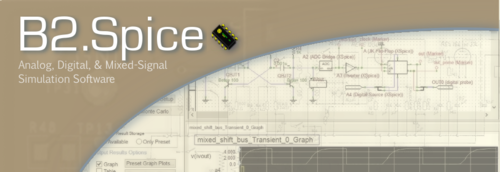Welcome to B2.Spice Wiki!
B2.Spice A/D Manual
Below are some links to help you get started using B2.Spice A/D.
- B2.Spice A/D: Getting Started
- An Overview of B2.Spice A/D Workshop
- Working with the Schematic Editor
- Analog and Mixed-Mode Circuit Simulation
- Digital Circuit Simulation
- Analyzing Circuits Using B2.Spice A/D Tests
- Using Device & System Parameters as Variables
- Parametric Sweeps and Monte Carlo Tests
- Using Virtual Instruments
- Observing Simulation Results Through Circuit Animation
- Visualizing Simulation Data Using Graphs and Tables
- Working with the Parts Database and Device Editor
- Working with Symbol Editor
- Working with Other Applications
- List of B2.Spice A/D Keyboard Shortcuts
- Glossary of Generic Analog Devices
- Glossary of Generic Digital and Mixed-Mode Devices
- Digital Device Part List
B2.Spice A/D Tutorial
Each tutorial lesson listed below walks you through the basic features of B2.Spice A/D covering many different topics. Lessons 1-4 teach you how to set up simple analog and digital circuits, perform various tests and live simulations and visualize the simulation results. In Lessons 5 and 6, you will learn how to create new parts, devices, simulation models and symbols using B2.Spice's versatile Device Editor.
- Tutorial Lesson 1 : A Simple Analog Voltage Divider Circuit
- Tutorial Lesson 2 : Time and Frequency Analysis of an RLC Filter
- Tutorial Lesson 3 : Analyzing a Bipolar Junction Transistor (BJT) Circuit
- Tutorial Lesson 4 : Building a Three-Input Digital AND Function
- Tutorial Lesson 5 : Creating a New Part from Your Circuit
- Tutorial Lesson 6 : Creating a Parameterized Subcircuit Part
- Tutorial Lesson 7 : Analyzing CMOS Logic Circuits
- Tutorial Lesson 8 : Designing Op-Amp Amplifiers
- Tutorial Lesson 9 : Building Your Own Reusable Binary Adder Digital Devices
- Tutorial Lesson 10 : Analyzing an Integrated Circuit Voltage Comparator
- Tutorial Lesson 11 : Exploring Flip-Flops and Sequential Logic Circuits
- Tutorial Lesson 12 : Designing Active Filters Using Op-Amps
- Tutorial Lesson 13 : Designing Low and High Frequency Oscillator Circuits
- Tutorial Lesson 14 : Building Mixed-Mode Circuits and D/A Converters
- Tutorial Lesson 15 : Using Switches to Build Sample-And-Hold Mixed-Mode Circuits
